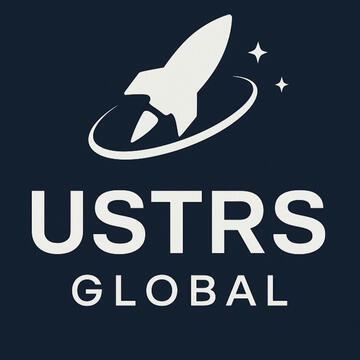
Universal Space-Time Referencing System (USTRS)
The Universal Space-Time Referencing System (USTRS) is a groundbreaking global framework designed to pinpoint any object, spacecraft, or event in the universe - precisely in both space and time.As humanity expands beyond Earth, USTRS provides the essential infrastructure to navigate, synchronize, and operate across the Moon, Mars, deep space, and beyond. Scalable, modular, and future-ready, USTRS bridges existing systems and charts a path toward interplanetary coordination.Explore how USTRS is building the foundation for the next era of space exploration and cosmic civilization.USTRS abstracts, articles, white papers, and other documents will be available at OSF: https://osf.io/ksu38/
USTRS FAQs
USTRS FAQ (For General Public)
What is USTRS?
USTRS stands for Universal Space-Time Referencing System. It’s a proposed global standard that gives every location in space - and every moment in time - a unique, easy-to-use code. Like GPS, but for the whole universe, not just Earth.
________________________________________
Why do we need USTRS?
As humanity ventures beyond Earth, we need a better way to describe where things are—not just on Earth or in orbit, but on the Moon, Mars, asteroids, and eventually other star systems. Current systems are not built for this scale. USTRS helps us identify locations and events anywhere in space and time.
________________________________________
Who invented USTRS?
USTRS was created by Javier A. Hernandez, an independent systems theorist, innovator, and researcher. He noticed that there was no universal framework for pinpointing space-time positions across multiple celestial bodies and missions and designed USTRS to fill that gap.
________________________________________
How does USTRS work?
USTRS divides space into cubic sectors and subsectors based on known astronomical units:
• 1 AU (the distance from Earth to the Sun) is a “sector.”
• 1 parsec (3.26 light years) becomes a “super-sector.”
• Distances can zoom in (to meters or kilometers) or out (to kiloparsecs or megaparsecs).
Each spatial sector is combined with a time index - so you always know where something is and when it was there. This combination is called a Universal Location Code (ULC).
________________________________________
What is a ULC?
A Universal Location Code is like a space-time "zip code." It uniquely identifies a physical location and a specific moment, such as:ULC::Sx+001:Sy-002:Sz+003:T2460480:MilkyWay:Sol:Earth:SJ0:GPS(40.7128,-74.0060,10m)This tells you the spatial sector and the time coordinate (like the 45.678th year from a set epoch). It’s scalable, precise, and universal.
________________________________________
How is USTRS different from GPS, GLONASS, or ICRF?
• GPS / GNSS: Earth-bound systems that cannot operate in deep space.
• ICRF (International Celestial Reference Frame): Based on fixed quasars, good for astronomy, not time-sensitive or dynamic navigation.
• USTRS:
o Works everywhere in space
o Includes time
o Modular, scalable, civilization-ready
________________________________________
What can USTRS be used for?
• Spacecraft navigation between planets and stars
• Lunar and Martian GPS-equivalents
• Coordination of interplanetary satellites
• Event reporting (e.g., meteor impact at X|Y)
• AI-powered autonomous navigation
• Space-time data tagging in astronomy
• Future interstellar commerce or diplomacy
________________________________________
What happens when space gets more crowded?
USTRS is built to scale. As more objects, settlements, and missions appear in space, each will have its own ULC. This avoids confusion and creates order in an otherwise chaotic cosmic landscape.
________________________________________
Can USTRS help with time travel or relativity?
USTRS is time-indexed, which means it is designed to handle time-based data, and could theoretically be adapted for relativistic corrections. USTRS is built with temporal relativity in mind.
________________________________________
Who can use USTRS?
• Space agencies (NASA, ESA, etc.)
• Spacecraft manufacturers
• Astronomers
• Universities
• Private space companies
• The general public (via apps or APIs in the future)
________________________________________
Is USTRS being used right now?
It is currently in the proposal and patent-pending phase. It is published on OSF (Open Science Framework) and will soon be submitted to peer-reviewed journals. You can be part of the movement by learning, sharing, and supporting its adoption.
________________________________________
What makes USTRS revolutionary?
USTRS is the first proposed universal system that integrates spatial and temporal coordinates into a unified, scalable, and standardized framework - paving the way for a functional galactic GPS.
________________________________________
Where can I learn more and follow updates?
• Website: USTRS.space
• Read the white paper on OSF
• Follow on X (Twitter): @USTRSGlobal
________________________________________USTRS FAQ (For Astronomers and Space Scientists)
________________________________________
What is USTRS?
The Universal Space-Time Referencing System (USTRS) is a four-dimensional (4D), scalable, cosmocentric coordinate framework designed to provide a universal method of locating, tagging, and synchronizing any object or event in space and time. It integrates:
• A 3D Cartesian spatial grid scaled in Astronomical Units (AU)
• A temporal axis based on the Julian Date (JD)
• A machine-readable output string called the Universal Locator Code (ULC)
• Stellar triangulation for position estimation
• Optional planetary and Earth-based synchronization nodes (e.g., EJD-SJ)
________________________________________
What scientific gap does USTRS fill?
Current systems are domain-limited:
• GNSS (e.g., GPS, Galileo) is Earth-centric, altitude-limited, and non-operational in deep space.
• ICRF provides fixed celestial references, not real-time navigation or spatiotemporal codes.
• No system provides operational 4D localization with both time and position at cosmic scale.
USTRS addresses this by introducing:
• Operational spatiotemporal resolution beyond planetary boundaries
• A universal and interoperable location/time encoding
• Real-time dynamic referencing for interplanetary and interstellar systems
________________________________________
How does USTRS work structurally?
1. Spatial Grid:
o AU-based cubic sectors, subdivided into microsectors (0.01 AU or finer)
o Sector indices (x, y, z) define location in space from the Solar System barycenter
2. Temporal Layer:
o Uses Julian Date (JD) as the time axis
o Enhanced by EJD-SJ (Extended Julian Date – San Juan) for Earth-based temporal anchoring
3. Triangulation Engine:
o Uses fixed celestial objects (quasars, pulsars, stars) for relativistic triangulation and vector analysis
o Algorithms solve position based on VLBI cataloged references and observed angular data
4. ULC Generation:
o Encodes all of the above into a modular, scalable alphanumeric Universal Locator Code (ULC)
________________________________________
What is the Universal Locator Code (ULC)?
A ULC is a hierarchical, 4D alphanumeric string encoding an object’s:
• AU-sector coordinates (Sx, Sy, Sz)
• Julian date timestamp (T)
• Galactic and planetary region
• Optional sub-objects and GPS data (lat/lon/alt for conversion)
Example:ULC::Sx+001:Sy-002:Sz+003:T2460480:MilkyWay:Sol:Earth:SJ0:GPS(40.7128,-74.0060,10m)
This enables universal localization and event timestamping, whether for a gamma-ray burst or a Mars rover.
________________________________________
What is EJD-SJ and why is San Juan used as an anchor?
EJD-SJ (Extended Julian Date – San Juan) is a modified Julian Date that includes a fixed geodetic offset from San Juan, Puerto Rico.
Reasons for SJ0 as Earth’s origin node:
• Geographically balanced location in the Caribbean between four continents
• Stable longitude (no Daylight Savings Time)
• Culturally neutral and historically symbolic (inventor’s birthplace, Arecibo legacy)
• Used for Earth-to-ULC conversion, GPS integration, and cross-system logging
________________________________________
What are planetary coordination nodes and how do they function?
Each celestial body can have a USTRS origin node for its own (0,0,0) sector indexing, such as:
• MA0: Base of Olympus Mons (Mars)
• LN0: Tranquility Base (Moon)
• CR0: Occator Crater (Ceres)
These nodes:
• Provide planet-local sector grids
• Enable planetary referencing and conversion
• Assist in surface-to-space triangulation
ULCs can integrate these for multi-body synchronization.
________________________________________
How does USTRS perform positioning without satellites?
Instead of satellite trilateration (GNSS), USTRS uses:
• Stellar triangulation via fixed star/pulsar references
• Vector analysis based on angle measurements and light travel time
• Relativistic corrections for signal delay and frame transformations
This method allows for positioning:
• Anywhere in the solar system and beyond
• With no dependence on artificial satellite constellations
________________________________________
What is the coordinate origin and orientation?
• Origin: Solar System barycenter at J2000 epoch
• Axes:
o X: toward vernal equinox (RA = 0)
o Y: orthogonal to X, in ecliptic plane
o Z: toward north celestial pole
This preserves consistency with celestial mechanics, JPL ephemerides, and ICRF orientation.
________________________________________
What are USTRS spatial scaling tiers?
Tier Name Volume Use Case
1 Sector 1 AU³ Planetary and interplanetary navigation
2 Super-Sector 1 pc³ (206,265 AU)³ Stellar and exoplanet mapping
3 Mega-Sector 1 kpc³ (1,000 pc)³ Galactic structure and simulation
ULC syntax reflects this hierarchy for precise cosmic referencing.
________________________________________
How does USTRS integrate with existing systems?
USTRS includes a compatibility layer to translate or map:
• GPS coordinates (lat, lon, alt) + time → ULC
• GNSS ephemerides into ULC-compatible logs
• ICRF vectors and VLBI data for triangulation
EJD-SJ allows seamless synchronization between Earth-based timekeeping and cosmic ULC timestamps.
________________________________________
Is USTRS real-time capable?
Yes. While USTRS is built on static astronomical constants, its real-time use depends on:
• Vector and signal-time data from spacecraft sensors
• Preloaded star catalogs
• Autonomous or AI-powered navigation modules
ULC generation can be autonomous, distributed, and machine-processed.
________________________________________
Applications in Astronomy and Space Sciences
1. Deep-space spacecraft localization
2. Precision logging of astronomical events
3. Autonomous rover tracking on Mars or Moon
4. Cataloging exoplanets and stellar phenomena
5. Interplanetary cargo logistics
6. Lunar, Martian, or orbital base registry systems
7. Space-time correlation for cosmic observations
8. Cross-agency data alignment and mission coordination
________________________________________
Where can I access the technical models and documentation?
• OSF Repository: https://osf.io (Search: USTRS or Javier Alfary)
• Patent Filing: USPTO PPA filed under inventor Javier A. Hernandez
Founder: Javier Alfary

Javier A. Hernández, known publicly as Javier Alfary, is a Puerto Rican author, interdisciplinary theorist, international educator, and multilingual innovator committed to advancing the frontiers of human knowledge across science, language, politics, and sovereignty. Born in San Juan, Puerto Rico, he has emerged as a powerful voice in decolonization theory, nation-building, and systems modeling, uniquely combining scientific vision with cultural advocacy and political strategy.He is the originator of the Universal Spacetime Reference System (USTRS) - a groundbreaking astronomical framework designed to standardize the spatial and temporal mapping of celestial coordinates across cosmic scales. This model, considered the "Galactic GPS", provides a critical solution to humanity’s need for a non-Earth-centric coordinate system as we explore the solar system and beyond. For more information, visit: https://javieralfary.carrd.co/
On X: @JavierAlfary
Contact Us
We welcome collaboration, questions, and engagement from scientists, agencies, educators, and space enthusiasts around the world.To learn more or get involved:
1. visit www.USTRS.space
2. email us at: [email protected]
3. or connect with us on X (formerly Twitter) at @ustrsglobal.Join us as we build the space-time infrastructure of the future.